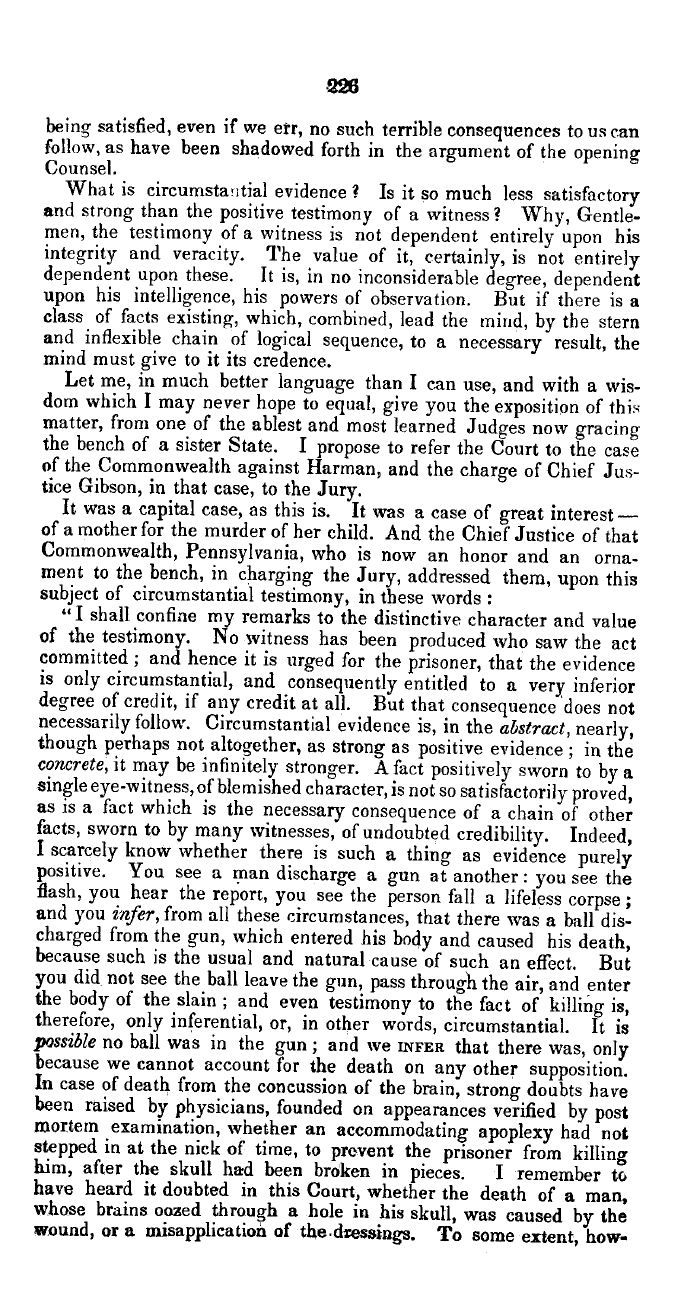|
being satisfied, even if we err, no such terrible consequences to us can
follow, as have been shadowed forth in the argument of the opening
Counsel.
What is circumstwitial evidence ? Is it so much less satisfactory
and strong than the positive testimony of a witness? Why, Gentle-
men, the testimony of a witness is not dependent entirely upon his
integrity and veracity. The value of it, certainly, is not entirely
dependent upon these. It is, in no inconsiderable degree, dependent
upon his intelligence, his powers of observation. But if there is a
class of facts existing, which, combined, lead the mind, by the stern
and inflexible chain of logical sequence, to a necessary result, the
mind must give to it its credence.
Let me, in much better language than I can use, and with a wis-
dom which I may never hope to equal, give you the exposition of this
matter, from one of the ablest and most learned Judges now gracing
the bench of a sister State. I propose to refer the Court to the case
of the Commonwealth against Harman, and the charge of Chief Jus-
tice Gibson, in that case, to the Jury.
It was a capital case, as this is. It was a case of great interest
of a mother for the murder of her child. And the Chief Justice of that
Commonwealth, Pennsylvania, who is now an honor and an orna-
ment to the bench, in charging the Jury, addressed them, upon this
subject of circumstantial testimony, in these words
"I shall. confine my remarks to the distinctive character and value
of the testimony. No witness has been produced who saw the act
committed ; and hence it is urged for the prisoner, that the evidence
is only circumstantial, and consequently entitled to a very inferior
degree of credit, if any credit at all. But that consequence does not
necessarily follow. Circumstantial evidence is, in the abstract, nearly,
though perhaps not altogether, as strong as positive evidence ; in the
concrete, it may be infinitely stronger. A fact positively sworn to by a
single eye-witness, of blemished character, is not so satisfactorily proved,
as is a fact which is the necessary consequence of a chain of other
facts, sworn to by many witnesses, of undoubted credibility. Indeed,
I scarcely know whether there is such a thing as evidence purely
positive. You see a man discharge a gun at another: you see the
flash, you hear the report, you see the person fall a lifeless corpse ;
and you infer, from all these circumstances, that there was a ball dis-
charged from the gun, which entered his body and caused his death,
because such is the usual and natural cause of such an effect. But
you did not see the ball leave the gun, pass through the air, and enter
the body of the slain ; and even testimony to the fact of killing is,
therefore, only inferential, or, in other words, circumstantial. It is
possible no ball was in the gun; and we INFER that there was, only
because we cannot account for the death on any other supposition.
In case of death from the concussion of the brain, strong doubts have
been raised by physicians, founded on appearances verified by post
mortern examination, whether an accommodating apoplexy had not
stepped in at the nick of time, to prevent the prisoner from killing
him, after the skull had been broken in pieces. I remember to
have heard it doubted in this Court, whether the death of a man,
whose brains oozed through a hole in his skull, was caused by the
wound, or a misapplication of the.dressings. To some extent, how-
|

